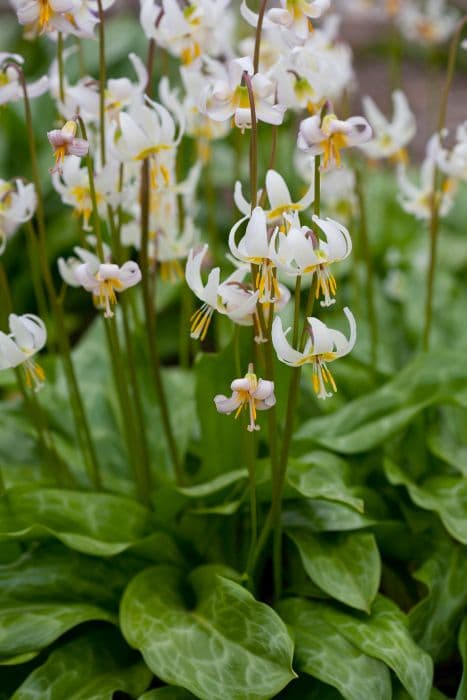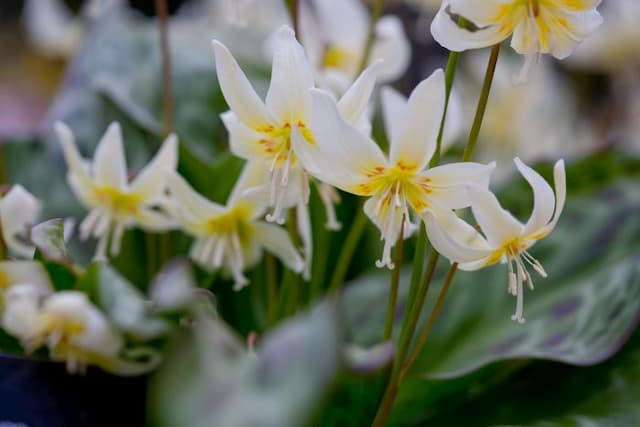Martagon lily Lilium martagon (Ixc/d)

ABOUT
The plant commonly known as Martagon lily or Turk's cap lily is known for its distinctive and attractive flowers. Each flower is typically a curved, backward-facing shape, which is why it's referred to as a "Turk's cap." The petals are usually a deep pink or purple color with darker spots scattered all over. The plant has a whorled leaf arrangement, with the leaves often densely clustered. The leaves are lance-shaped, with edges that can be smooth or slightly wavy. The overall effect of the spiraling leaves and nodding, spotted blooms gives this plant an elegant yet whimsical appearance that can add interest to any garden. The blooms have a delicate fragrance and are attractive to various pollinators, including bees and butterflies.
About this plant
 Names
NamesFamily
Liliaceae
Synonyms
Martagon Lily, Turk's Cap Lily, Dragon Lily, Turkish Cap, Sultan's Lily
Common names
Lilium martagon var. cattaniae Vis., Lilium martagon var. dalmaticum Vis., Lilium martagon subsp. pilosiusculum Freyn, Lilium martagone Chaix, Lilium martagon subsp. martagon.
 Toxicity
ToxicityTo humans
The plant commonly known as Turk's cap lily, Lilium martagon, contains compounds that are considered toxic to humans if ingested. Though the toxic constituents vary across different parts of the plant, ingestion can lead to symptoms such as nausea, vomiting, abdominal pain, and diarrhea. In severe cases, symptoms could escalate to include heart rhythm disturbances, seizures, and potentially life-threatening conditions. These toxic effects are due to the presence of compounds like colchicine and other alkaloids. It is important to note that all parts of the plant are considered toxic, and consumption, especially in large amounts, should be avoided to prevent poisoning.
To pets
The plant known as Turk's cap lily, Lilium martagon, poses a significant risk to pets, especially cats. All parts of this plant are highly toxic to cats and can cause severe acute kidney failure even in small amounts. Symptoms of poisoning in pets can appear within a short time after ingestion and include vomiting, lethargy, loss of appetite, kidney failure, and without prompt veterinary care, may lead to death. Dogs are less sensitive than cats but still may experience mild gastrointestinal upset upon ingesting parts of the plant. It is crucial to prevent pets from accessing Turk's cap lily to avoid the possibility of toxic exposure.
 Characteristics
CharacteristicsLife cycle
Perennials
Foliage type
Deciduous
Color of leaves
Green
Flower color
Varies
Height
3-6 feet (0.9-1.8 meters)
Spread
1-2 feet (0.3-0.6 meters)
Plant type
Bulb
Hardiness zones
5
Native area
Europe
Benefits
 General Benefits
General Benefits- Ecological Support: Provides nectar and pollen for bees, butterflies, and other pollinators, thus contributing to the biodiversity of its environment.
- Aesthetic Value: With its distinctive turk's cap-shaped flowers and varied coloration, Turk's cap lily enhances the visual appeal of gardens and natural landscapes.
- Habitat Creation: Can be part of a habitat garden that supports wildlife, offering shelter and food to various species.
- Educational Interest: Turk's cap lily is often used in educational settings like botanical gardens to teach about plant biology and diversity.
- Cultural Significance: Many cultures appreciate Turk's cap lily for its beauty and symbolism, often incorporating it into art and literature.
- Gardening and Horticulture: Popular among gardeners for its hardiness and low maintenance requirements, making it a preferred choice for perennial borders and woodland gardens.
- Soil Erosion Control: This plant can help stabilize soil in sloped areas or gardens, reducing the risk of erosion.
 Medical Properties
Medical Properties- Antiseptic: Traditionally used for its cleansing properties to help treat wounds.
- Diuretic: Has been used to promote urine production and relieve water retention.
- Emmenagogue: Reported to have properties that stimulate menstrual flow.
- Astringent: Used for its ability to contract skin cells and tissue, thereby reducing bleeding and secretion.
 Air-purifying Qualities
Air-purifying QualitiesThis plant is not specifically known for air purifying qualities.
 Other Uses
Other Uses- Lilium martagon, commonly known as Martagon lily, has traditionally been used in floral arrangements, particularly in Europe, and is prized for its distinctive turk's cap-like flowers and longevity in bouquets.
- The bulbs of the Martagon lily were historically ground into a paste and used as a starch for stiffening clothes, although this practice is now outdated with modern alternatives.
- In horticulture, the Martagon lily is used as a parent in hybridizing efforts to create new lily varieties with its desirable hardiness and shade tolerance.
- The Martagon lily serves as an important nectar source for pollinators such as bees and butterflies, helping to sustain local ecosystems.
- Culinary enthusiasts sometimes pickle the small bulbs of the Martagon lily, although this is not a widespread practice due to the bulb's bitter taste.
- The plant has been used as a natural insect repellant in the past by placing crushed leaves around living areas to deter flies and mosquitos.
- Martagon lilies can be planted in woodland gardens to help stabilize the soil and prevent erosion with their extensive root systems.
- Aesthetic uses include cultivation for ornamental purposes in shaded rock gardens, where the Martagon lily's tolerance for low light can be showcased.
- In some regions, the dried seed pods of the Martagon lily are utilized in craftwork and dried flower arrangements for their unique shape and texture.
- Fishermen have been said to use the sap from the Martagon lily as a minor fish sedative to aid in fishing, a use based on folklore and not supported by scientific evidence.
Interesting Facts
 Feng Shui
Feng ShuiThe Martagon lily is not used in Feng Shui practice.
 Zodiac Sign Compitability
Zodiac Sign CompitabilityThe Martagon lily is not used in astrology practice.
 Plant Symbolism
Plant Symbolism- Purity: The Lilium martagon, commonly known as the Turk's cap lily, is often associated with the idea of purity due to its delicate and pristine flowers that are characteristic of the broader lily family.
- Royalty: Throughout history, lilies have been connected to royal bloodlines and nobility, and the Turk's cap lily, with its regal appearance, is no exception to this association.
- Wealth: The lush and full blooms of the Turk's cap lily can represent abundance and wealth, symbolizing the flourishing of resources or prosperity.
- Fertility: The reproductive nature of flowers, coupled with the Turk's cap lily's numerous and often prolific blooms, can symbolize fertility or the creation of life.
- Rebirth: Similar to other lilies, the Turk's cap lily's lifecycle, which sees it die back and bloom again each year, is a powerful symbol of renewal and rebirth.
 Water
WaterThe Martagon lily, commonly known as Turk's Cap lily, requires even moisture, especially during its growing season. Water the plant when the top inch of soil feels dry, which typically equates to once a week, though this can vary depending on temperature and humidity. Each watering should provide enough moisture to soak the soil around the roots, which might be approximately 1 to 1.5 gallons for an established plant in a garden setting. During the dormant season in late fall and winter, reduce watering frequency to prevent the bulb from rotting.
 Light
LightTurk's Cap lily thrives in dappled sunlight or part shade. It is best to position the plant where it can receive morning sun and afternoon shade, or under the canopy of light trees. Too much direct sun can scorch the leaves and flowers, while too little can lead to weak growth and fewer flowers.
 Temperature
TemperatureTurk's Cap lily prefers temperate climates and grows best in conditions between 60°F and 70°F. This plant can survive minimum winter temperatures down to 20°F but may need mulch for protection. During the growing season, avoid exposure to temperatures above 80°F as this can stress the plant.
 Pruning
PruningPruning the Turk's Cap lily is generally done after blooming, to remove spent flowers and prevent seed production, which can deplete the plant's energy. Cut the stalk down to the base in late fall to prepare for winter dormancy. This lily requires minimal pruning otherwise, and cleaning up debris and dead foliage can help maintain plant health.
 Cleaning
CleaningAs needed
 Soil
SoilFor the Turk's Cap Lily, a well-draining soil mix with high organic content is best. A mixture of loam, sand, and peat with a pH of 6.0 to 6.5 will provide the right conditions for it to thrive.
 Repotting
RepottingThe Turk's Cap Lily typically requires repotting every 3 to 4 years to rejuvenate the soil and give bulbs space to grow.
 Humidity & Misting
Humidity & MistingTurk's Cap Lily fares well in moderate humidity levels, without the need for a highly humid environment.
 Suitable locations
Suitable locationsIndoor
Use well-draining soil and provide bright, indirect light indoors for Turk's Cap Lily.
Outdoor
Plant in a sheltered spot with partial shade and well-draining soil for Turk's Cap Lily.
Hardiness zone
3-9 USDA
 Life cycle
Life cycleThe life of the Martagon lily (Lilium martagon), commonly known as Turk's cap lily, begins with seed germination, where the conditions must be cool and moist, usually taking place in the spring. The germinated seedlings develop into bulbils, which grow at or just below the soil surface. As the seedlings mature, they form bulbs that will experience a period of dormancy over the winter months. With the arrival of warm spring weather, the bulbs break dormancy and produce stems with whorled leaves, leading to the development of the characteristic purple or pink, turban-shaped flowers by early summer. After flowering, the plant sets seed, which is dispersed late in the summer or in the fall, ensuring the continuance of the species. Following seed dispersal, the above-ground parts of the plant die back, with the underground bulb persisting through the winter to complete the cycle.
 Propogation
PropogationPropogation time
Spring to early summer
Lilium martagon, commonly known as Martagon Lily, is typically propagated by the division of its bulb scales. The best time to propagate this species is in late summer to autumn, after the foliage has died back, which allows the bulbs to go dormant. To propagate by bulb scales, carefully break off a scale from the mature bulb and plant it base down in a mixture of peat and perlite, covering it with about 0.5 inches (around 1.27 centimeters) of the medium. The scale should be kept moist and in a cool, shaded location until roots and a small bulb develop, a process that can take a few months. Once a new bulb has formed and shows signs of growth, it can be transplanted to a more permanent location. This method leverages the natural storage and regenerative abilities of the bulb, encouraging new bulb growth from the detached scale.









